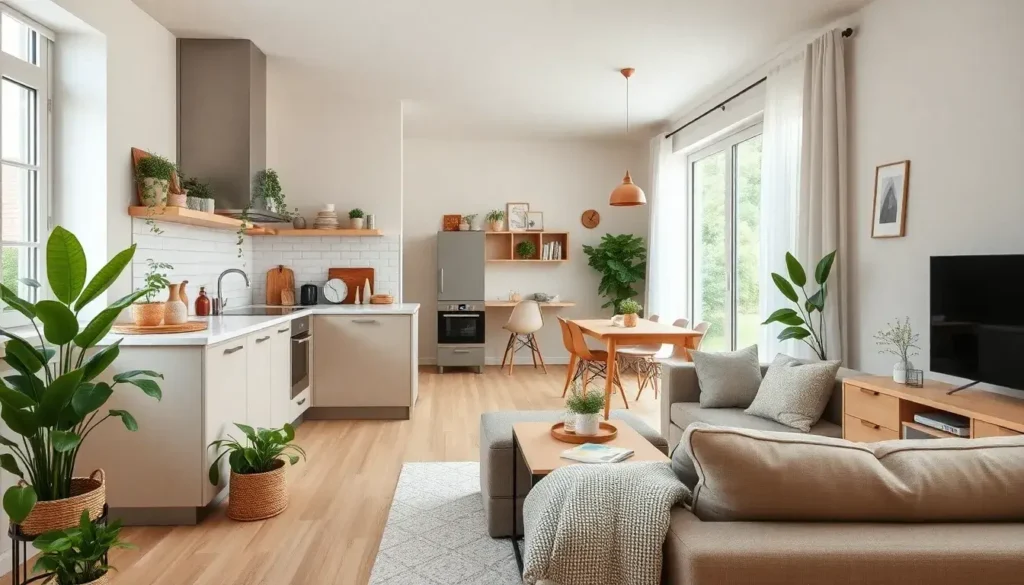Creating a cozy home in a small apartment can feel like a puzzle, especially when you want that modern touch without compromising on style. With the rise of urban living, many of us are searching for ways to maximize our space while keeping things sustainable. That’s why I put together this list of over 30 apartment small open plan kitchen living room ideas that work. These ideas not only make your space feel bigger but also ensure it reflects your personality and values.
If you’re an urban dweller who loves home decor, this post is just for you. Whether you’re a first-time renter or looking to refresh your current layout, you want solutions that are stylish, functional, and environmentally friendly. You care about how your living space looks and feels, and you want it to be a reflection of who you are.
In this post, you’ll discover practical tips and tricks for creating an open concept feel in your kitchen and living room. From eco-friendly materials to multi-functional furniture that saves space, I’ve gathered a range of ideas that can transform your apartment into a beautiful haven. Get ready to explore creative solutions that maximize every square foot while making your home a warm and inviting place to be.
So, grab a cup of coffee, and let’s dive into these inspiring small space designs that blend functionality with aesthetics. You’re bound to find something that sparks your creativity and helps you create the stylish living environment you’ve been dreaming of.
Key Takeaways
– Explore eco-friendly materials that add a modern touch while being kind to the planet.
– Discover how open shelving can keep your kitchen accessible and organized.
– Learn about compact dining solutions that fit seamlessly into your small space.
– Find out how multi-functional furniture can elevate your living experience and save space.
– Get inspired by creative lighting solutions that enhance the ambiance of your apartment.
1. Eco-Friendly Materials for a Modern Look
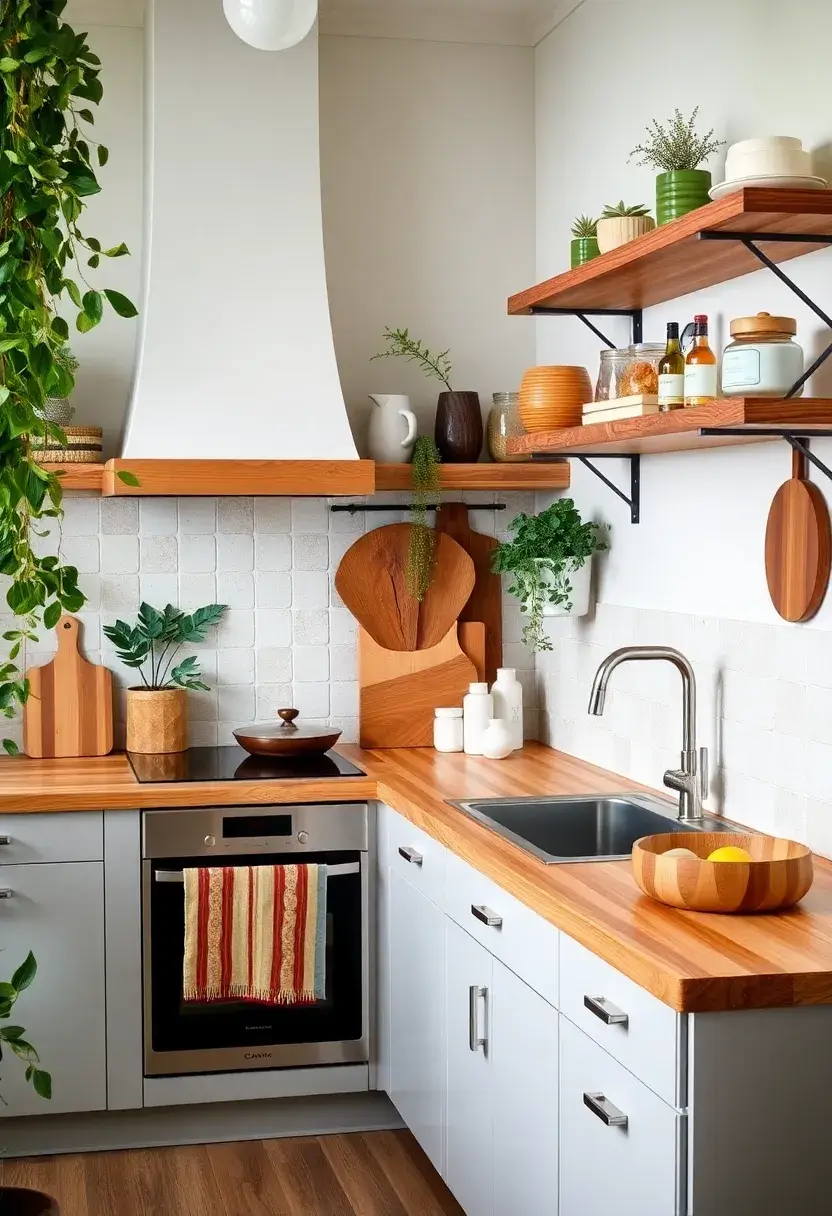
Choosing eco-friendly materials in your kitchen-living space helps both the planet and your style. Imagine bamboo countertops and reclaimed wood shelves that bring a warm, natural feel. These materials not only look great but also stand the test of time while being easy to care for. Pinterest is buzzing with these trends, so you can be right on track with the latest designs.
To implement this look, search for local suppliers of sustainable materials or visit home improvement stores for budget-friendly options. For a cohesive look, pair these elements with neutral colors to highlight their textures. This approach creates a home that feels welcoming and connected to nature, perfect for family gatherings or quiet evenings at home.
• Use bamboo countertops for durability and style
• Choose reclaimed wood shelves for a rustic touch
• Opt for low-VOC paints to improve air quality
• Incorporate natural fibers in textiles for comfort
By embracing eco-friendly materials, you’ll craft a beautiful living space that feels warm, inviting, and respectful of the environment.
Did you know bamboo countertops can be as durable as traditional stone and are 100% renewable when harvested responsibly? Choose reclaimed wood shelves to add warmth and cut waste—perfect for apartment small open plan kitchen living room ideas.
Eco-Friendly Materials for a Modern Look
Editor’s Choice

Star War Wooden Spoons Kitchen Cooking Utensils, Wooden Bamboo Utensil S…
 Amazon$8.29
Amazon$8.29
Reclaimed Wood Floating Shelves Real Solid Thick Wood Rustic Shelf Handmade
 Amazon$59.99
Amazon$59.99
1 LB 5x20mm Glass Strips Mosaic Tiles for Home Decoration, Mini Recycled…
 Amazon$16.99
Amazon$16.992. Open Shelving for Easy Access

Open shelving can make your small kitchen feel larger and more inviting. These shelves allow you to display your favorite dishes and kitchen essentials while keeping everything easily accessible. Whether you choose reclaimed wood for a rustic vibe or sleek metal for a modern touch, open shelving adds character to your space. You can find inspiration for this trend across many design blogs.
For a practical setup, arrange your most-used items at eye level and keep less attractive items higher up. This can be a cost-effective solution, especially if you create your shelves from reclaimed materials. Keep the shelves organized and clutter-free, making your kitchen feel tidy and stylish, perfect for hosting friends or family.
• Use reclaimed wood for a warm, rustic look
• Style with potted herbs for a fresh touch
• Keep colors cohesive for a tidy appearance
• Add greenery to soften hard surfaces
With these tips, your kitchen can become a beautiful showcase of your style, making it a place you love to spend time in.
Open Shelving for Easy Access
Editor’s Choice

Reclaimed Wood Floating Shelves Real Solid Thick Wood Rustic Shelf Handmade
 Amazon$59.99
Amazon$59.99
WOPITUES Floating Shelves with Black Metal Guardrail, Shelves for Wall D…
 Amazon$23.74
Amazon$23.74
Indoor Herb Garden Kit – 10 Non-GMO Herb Seeds with Soil, Pots & Moistur…
 Amazon$39.99
Amazon$39.993. Compact Dining Solutions
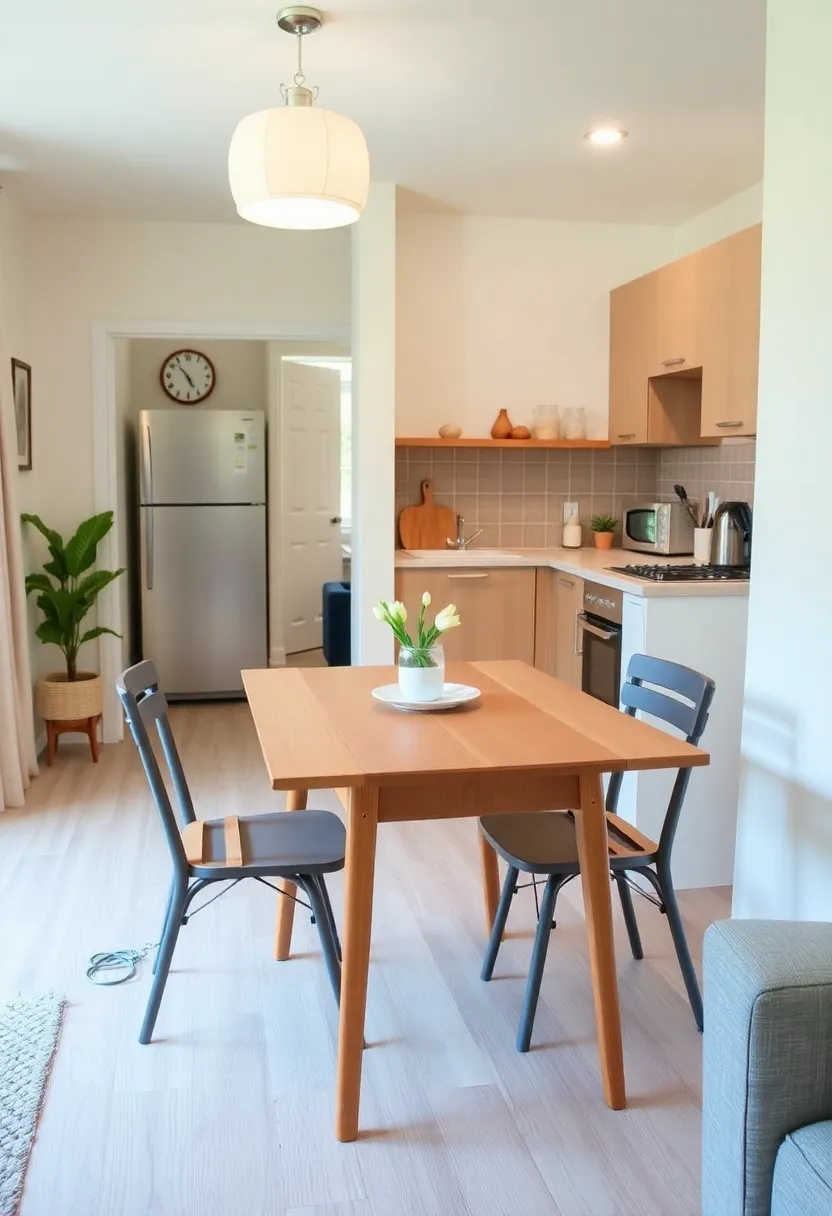
In small open plans, every piece of furniture counts, especially for dining. Compact solutions like drop-leaf tables can adapt to your needs while saving space. Pair these with stackable chairs that you can tuck away when not in use. This flexibility allows you to entertain comfortably without crowding.
Look for dining sets that offer built-in storage to maximize utility in your space. Consider bar stools at a kitchen island for casual meals. These choices help create an inviting atmosphere perfect for gatherings or quiet dinners.
• Choose drop-leaf tables for adaptable dining
• Use stackable chairs to save space
• Opt for a round table for a cozy feel
• Incorporate built-in storage to keep things organized
These compact dining solutions can help you enjoy every moment at home, whether you’re hosting or just having a quiet meal.
Compact Dining Solutions
Editor’s Choice

Winsome Taylor Drop Leaf Table with Wide Drawer, for Dining Room, 29″, W…
 Amazon$134.99
Amazon$134.99
Flash Furniture 4 Pack Hercules Series Trapezoidal Back Stacking Banquet…
 Amazon$168.40
Amazon$168.40
HOOBRO Bar Stools, Set of 2 Bar Chairs, 23.6 Inch Saddle Stools, Kitchen…
 Amazon$53.99
Amazon$53.994. Multi-Functional Furniture
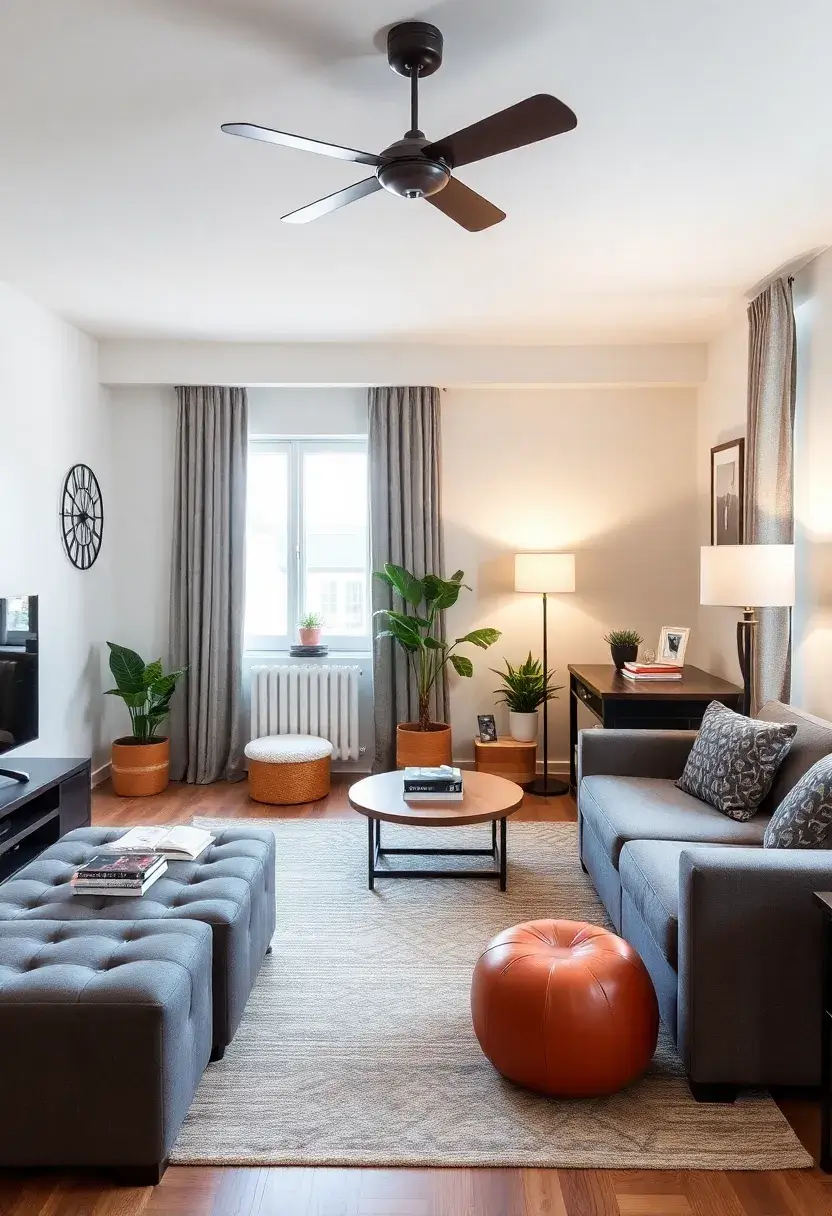
Multi-functional furniture is a lifesaver in small spaces. Look for items like a sofa bed for guests or a storage ottoman that can serve as a coffee table. These versatile pieces can transform your open plan into a functional oasis, maximizing every inch.
Shop for items that can easily change from one use to another. You can find affordable options at local furniture stores or online. This strategy not only saves space but also keeps your home looking stylish and organized, perfect for a cozy night in or entertaining friends.
• Choose a sofa bed for overnight guests
• Use a storage ottoman for dual purposes
• Select a fold-out desk for workspace convenience
• Opt for coffee tables with compartments for hidden storage
With these multi-functional pieces, you’ll create a stylish space that works hard for you.
Fun fact: 60% of urban apartments gain instant usability when you swap ordinary furniture for multi-functional pieces. A sofa bed plus a storage ottoman can double seating, sleeping space, and hidden storage in your apartment small open plan kitchen living room ideas.
Multi-Functional Furniture
Editor’s Choice

Homall Futon Sofa Bed, Leather Futon Couch with Removable Armrests, Adju…
 Amazon$139.99
Amazon$139.99
ALASDO Storage Ottoman Footrest Stool Small Ottoman with Storage Foldabl…
 Amazon$23.06
Amazon$23.06
IDEALHOUSE 70in TV Stand for TVs up to 80″, Mid Century Modern Entertain…
 Amazon$159.99
Amazon$159.995. Floating Furniture Layouts

Floating furniture layouts allow you to define your cooking and living areas without walls. Position your sofa away from the walls to create an open flow in your space. This setup encourages conversation and makes your area feel larger and more connected.
To effectively separate zones, consider using rugs to define each area. You could also add a small console table to bridge the gap between spaces. This arrangement enhances your room’s balance while ensuring it remains functional and stylish.
• Use area rugs to visually define spaces
• Incorporate a console table to create separation
• Maintain open pathways for movement
• Arrange furniture for a functional balance
This approach will help you maximize your space while creating a warm and inviting environment.
Floating Furniture Layouts
Editor’s Choice

HOMFINE Washable Modern Area Rug – Geometric Style 5×7 Rugs for Living R…
 Amazon$47.23
Amazon$47.23
Tribesigns Farmhouse Console Table, 47 Inches Entryway Console Table wit…
 Amazon$124.99
Amazon$124.99
Homall Futon Sofa Bed, Leather Futon Couch with Removable Armrests, Adju…
 Amazon$139.99
Amazon$139.996. Integrated Technology Solutions
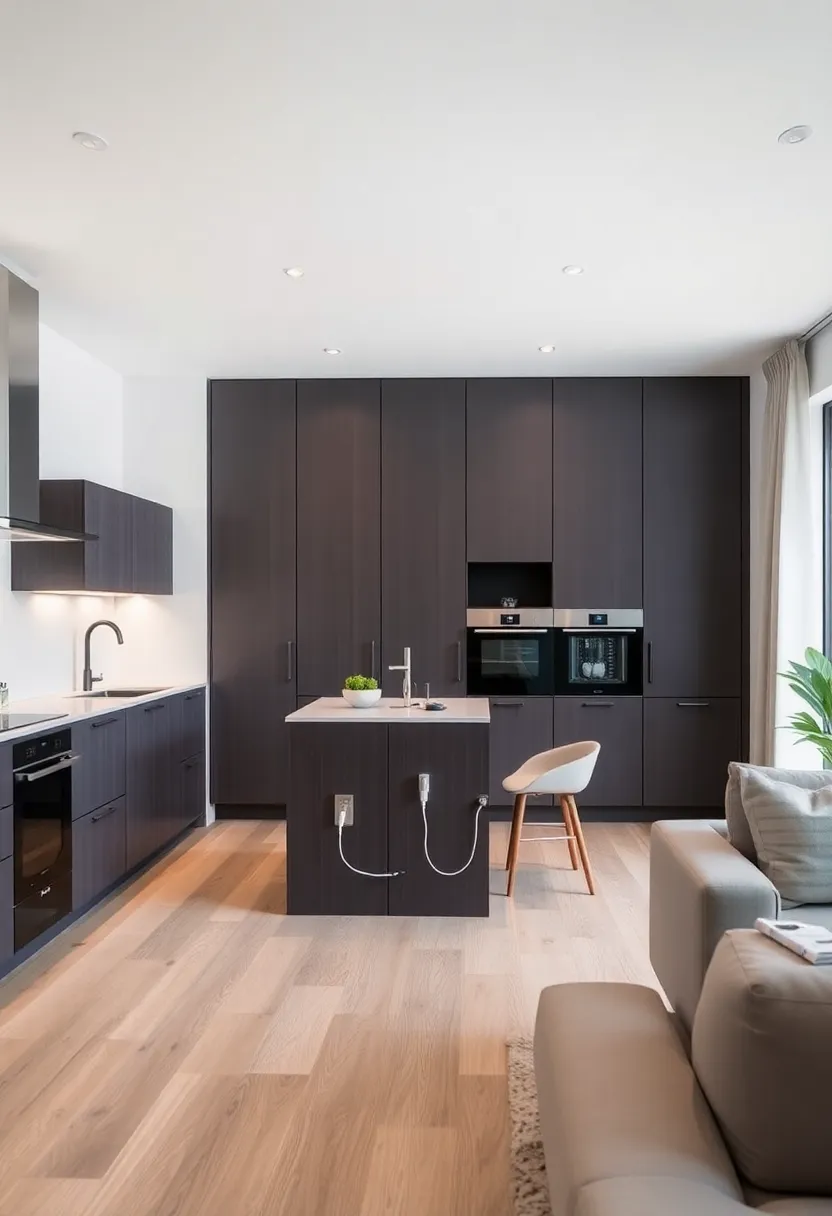
Integrating technology into your kitchen-living area can simplify your life. Think smart appliances like a Wi-Fi coffee maker that you can control from your phone. These devices blend seamlessly into your decor while adding convenience without clutter.
Shop for energy-efficient appliances that fit your style and needs. This tech-savvy approach can make daily tasks easier while keeping your space looking modern and sleek. It’s perfect for busy lifestyles, helping you enjoy both cooking and relaxation times.
• Look for smart appliances for convenience
• Add charging stations hidden in furniture
• Use smart lighting for ambiance control
• Incorporate built-in speakers for sound while cooking
With these integrated solutions, your home will be both functional and enjoyable, making every day a little easier.
Small-space living means every gadget should earn its keep. With Wi-Fi ovens, built-in speakers, and hidden charging stations, you can cook, relax, and recharge without clutter—Apartment small open plan kitchen living room ideas that actually work for urban dwellers.
Integrated Technology Solutions
Editor’s Choice

Hamilton Beach Works with Alexa Smart Coffee Maker, Programmable, 12 Cup…
 Amazon$97.99
Amazon$97.99
Govee Smart Light Bulbs, Color Changing Light Bulb, Work with Alexa and …
 Amazon$28.99
Amazon$28.99
Anker Soundcore 2 Portable Bluetooth Speaker with Stereo Sound, Bluetoot…
 Amazon$27.99
Amazon$27.997. Color Coordination for Cohesion
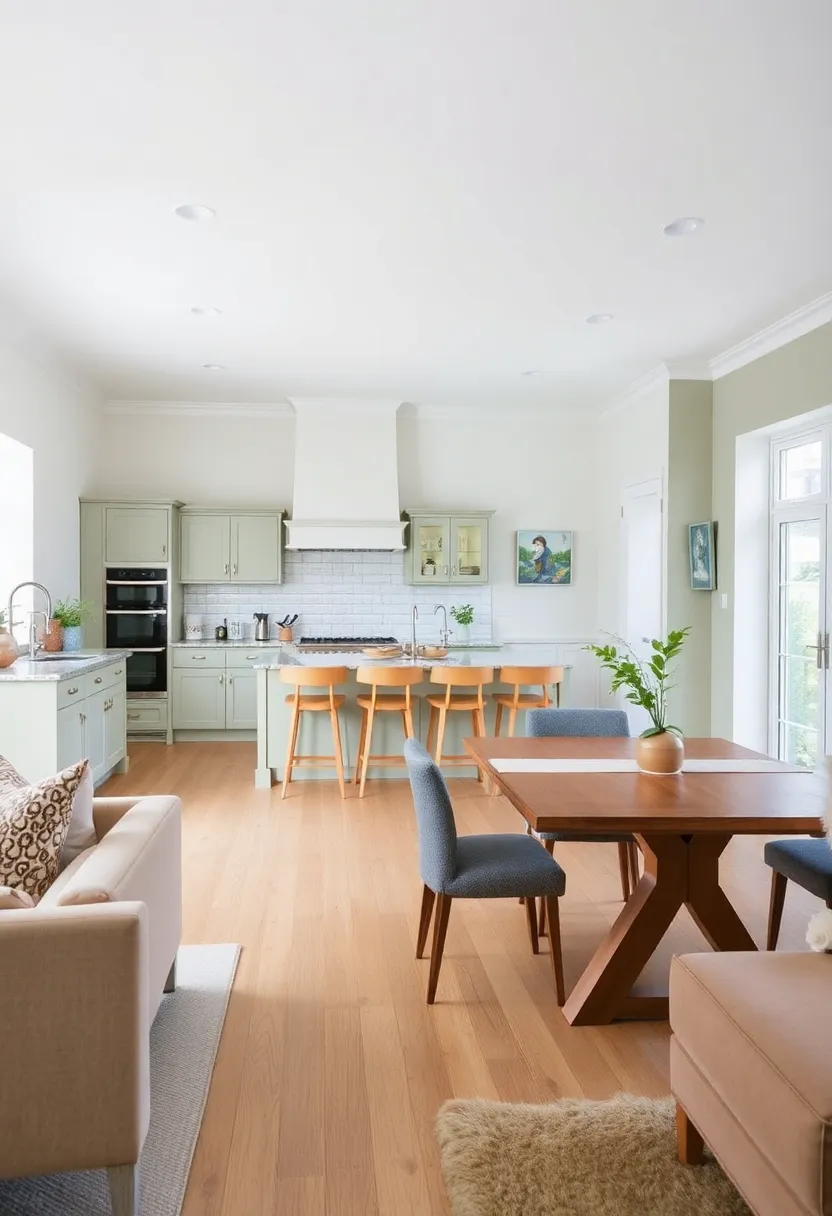
Color coordination can beautifully tie your open plan space together. Selecting a cohesive color palette helps create a seamless flow from the kitchen to the living area. Soft colors can make your space feel larger while bold accents draw the eye.
To create harmony, use textiles like cushions or curtains that reflect your kitchen’s colors. You might also consider a backsplash that connects both areas. This approach enhances your design sensibility while making your home warm and inviting.
• Choose soft hues for a spacious feel
• Use complementary colors for visual connection
• Incorporate cohesive textiles throughout
• Consider a consistent backsplash for unity
With careful color choices, your space will feel well-coordinated and stylish.
Color Coordination for Cohesion
Editor’s Choice

Menkxi Small Middle Finger Decorative Pillow 13.78 x 9.84 in Funny Shape…
 Amazon$14.99
Amazon$14.99
Homaxy 100% Cotton Terry Kitchen Towels(Black, 13 x 28 inches), Checkere…
 Amazon$9.59
Amazon$9.59
Retro Black And White Newspaper Poster What If It All Works Out Canvas W…
 Amazon$12.58
Amazon$12.588. Creative Lighting Solutions
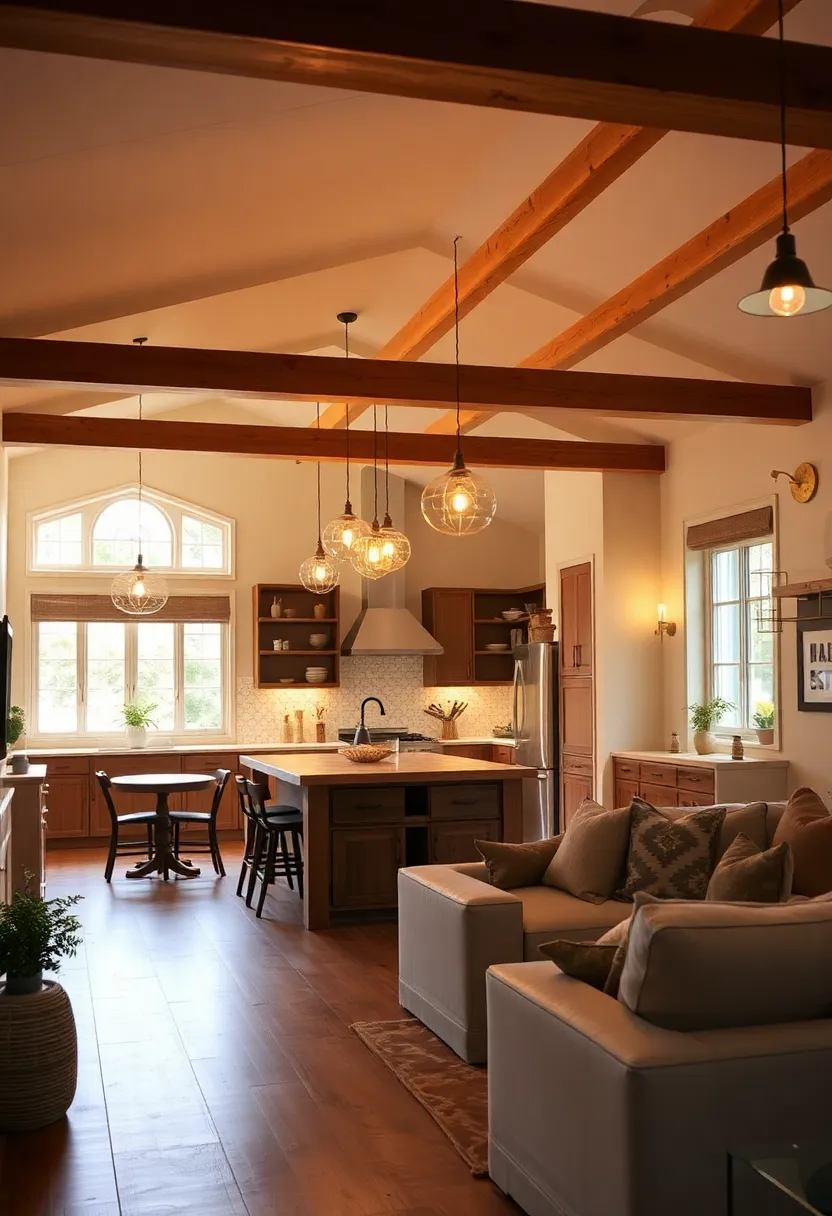
Lighting plays a vital role in any open plan design, especially where natural light is scarce. A mix of ambient, task, and accent lighting creates warmth and character. Think pendant lights over the kitchen island or strategic LED strips under shelves to enhance the vibe.
To adjust the mood, consider installing dimmers for flexibility. Use accent lighting to highlight artwork or specific areas. This thoughtful approach enhances functionality while adding personality to your space, perfect for both cooking and entertaining.
• Use pendant lights as focal points
• Install dimmers for adaptable ambiance
• Highlight features with spotlights
• Incorporate LED strips for modern flair
Good lighting can transform your area, making it feel inviting and lively.
Creative Lighting Solutions
Editor’s Choice

Newrays Antique Wood Wine Barrel Pendant Lamp Hanging Rustic Unique Kitc…
 Amazon$63.99
Amazon$63.99
Govee RGBIC LED Strip Lights, Smart LED Lights for Bedroom, Bluetooth LE…
 Amazon$13.49
Amazon$13.49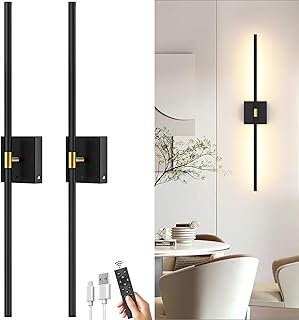
iThird Battery Operated Wall Sconce Set of 2: Rechargeable Wall Lights W…
 Amazon$53.99
Amazon$53.999. Indoor Gardens for Freshness

Bringing plants into your open space adds life and improves air quality. Wall planters, window sills, or hanging pots can integrate greenery into your kitchen-living area beautifully. Consider herbs like basil or mint for practicality as well as aesthetics.
For low maintenance, choose hardy plants like succulents or snake plants. Grouping plants together can create a mini indoor garden that serves as a visual focal point. This touch not only enhances your decor but also brings a calming atmosphere to your home.
• Choose low-maintenance plants for easy care
• Use vertical planters to save space
• Group plants for a mini indoor garden
• Incorporate herbs for beauty and function
These indoor gardens will not only beautify your decor but also promote a refreshing ambiance.
Indoor Gardens for Freshness
Editor’s Choice

2 Pcs Wall Mounted Hanging Planter Vase for Indoor and Outdoor Plants Mo…
 Amazon$34.99
Amazon$34.99
Shop Succulents Unique Succulent Plant Pack Collection – Live Mini Succu…
 Amazon$20.79
Amazon$20.79
Indoor Herb Garden Kit – 10 Non-GMO Herb Seeds with Soil, Pots & Moistur…
 Amazon$39.99
Amazon$39.9910. Textured Fabrics for Comfort
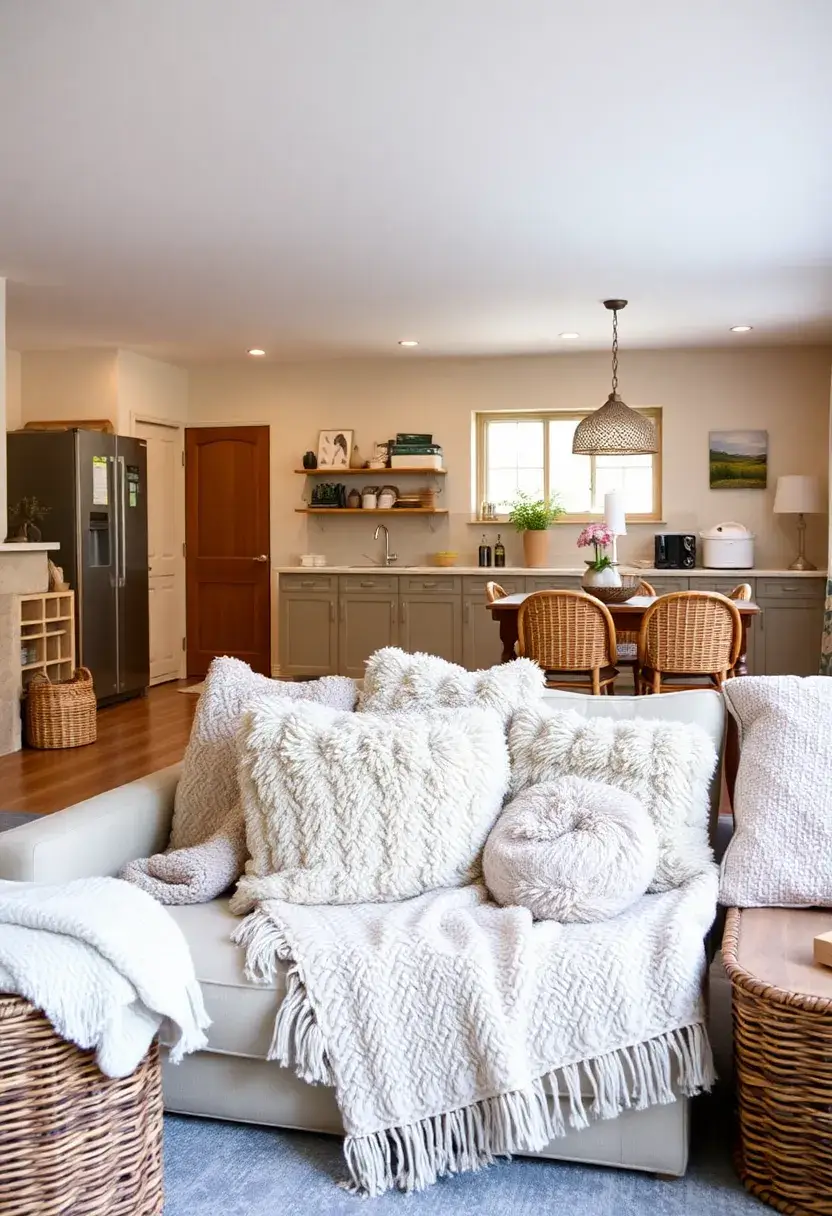
Adding various textures can create a cozy atmosphere in your open kitchen-living room. Think soft textiles like plush throws, velvet cushions, and wicker accents that invite relaxation. Mixing fabrics adds interest to your decor, making your space feel curated and warm.
To achieve a cozy feel, layer different fabrics on your sofa and use a jute rug for organic texture underfoot. Curtains that flow softly can enhance the space, balancing hard surfaces. This thoughtful approach makes your home feel welcoming and comfortable.
• Layer different fabrics on your sofa
• Use a jute rug for natural warmth
• Incorporate soft curtains for elegance
• Add plush throws for added coziness
These textured elements will create an inviting space that feels like home.
Textured Fabrics for Comfort
Editor’s Choice

Eddie Bauer – Blanket, Super Soft Reversible Sherpa & Brushed Fleece Bed…
 Amazon$59.99
Amazon$59.99
vctops Soft Velvet Chair Pads with Ties Comfy Solid Seat Cushion for Din…
 Amazon$24.99
Amazon$24.99
SAFAVIEH Area Rug 8×10 – Cape Cod Collection – Large – Natural Brown, Ha…
 Amazon$192.00
Amazon$192.0011. Minimalistic Decor Choices

Embracing minimalism in small open areas can work wonders. Select a few impactful decor pieces that resonate with your style instead of cluttering surfaces. This focus makes your space feel larger and more peaceful.
Choose a statement artwork to serve as your focal point. Concealed storage solutions can keep clutter at bay, ensuring a clean look. Opt for furnishings with clean lines to enhance your streamlined aesthetic, creating a tranquil environment.
• Select a statement artwork to draw attention
• Use concealed storage to minimize clutter
• Choose clean line furnishings for simplicity
• Limit decorations to a few meaningful items
This minimalist approach will help you create a serene and stylish home.
Minimalistic Decor Choices
Editor’s Choice

Monkey Street Graffiti Canvas Print Wall Art,-Follow Your Dreams Animal …
 Amazon$15.88
Amazon$15.88
Tactical CCW Fanny Bag, Concealed Carry Fanny Pack w/Adjustable Waist Be…
 Amazon$32.69
Amazon$32.69
Guardsman Deep Cleaning Wood Cleaner for Cabinets, Furniture, Tables, an…
 Amazon$7.99
Amazon$7.9912. Artistic Wall Treatments
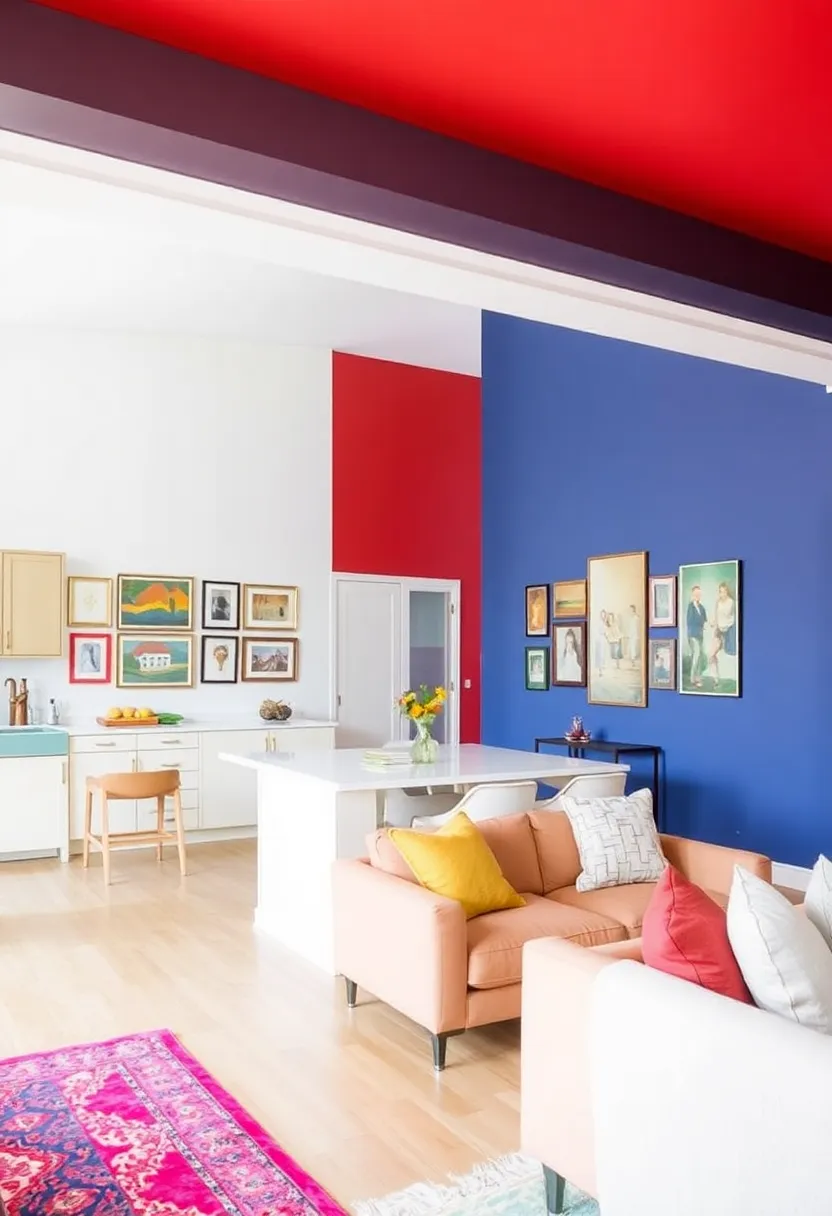
Artistic wall treatments can dramatically change the look of your open space. Consider removable wallpaper or bold paint colors to add personality without overwhelming the room. Your walls can serve as canvases that showcase your creativity and style.
For a striking effect, choose an accent wall or incorporate wall decals for easy updates. Framed art can help establish your theme and style. This creative approach will elevate your space and reflect your unique personality.
• Select a bold accent wall for impact
• Use wall decals for temporary changes
• Utilize framed art to establish your theme
• Create a gallery wall for diverse expression
These artistic touches can transform your home into a vibrant reflection of you.
Artistic Wall Treatments
Editor’s Choice

15.7″ X 118″ Black Silk Wallpaper Embossed Self Adhesive Peel and Stick …
 Amazon$5.59
Amazon$5.59
Heiple Framed Set of 3 Poker Wall Art Lucky You Poster, Trendy Retro Pri…
 Amazon$31.34
Amazon$31.34
Chinco Motivational and Inspirational Wall Decal Sticker – Grind Hustle …
 Amazon$7.99
Amazon$7.9913. Vintage and Thrifted Finds

Incorporating vintage and thrifted pieces into your kitchen-living area adds charm and character. Hunt for unique items like retro kitchenware or antique furniture that tells a story. These finds often cost less than new items and give your space a distinct personality.
Explore local flea markets or thrift stores for hidden treasures, and consider refurbishing old furniture to give it new life. Mixing vintage with modern decor creates a curated look that feels personal and inviting.
• Visit local flea markets for unique finds
• Refurbish old furniture for a fresh look
• Mix vintage items with modern decor for variety
• Look for quirky decor pieces to spark conversation
These unique additions will enhance your decor and promote a sustainable lifestyle.
Vintage and Thrifted Finds
Editor’s Choice

Enesco 6001023 Disney Ceramics Classic Film Posters Cookie Jar Canister,…
 Amazon$48.60
Amazon$48.60
REALINN Wood Furniture Repair Kit- Set of 28 – Touch Up Markers, Fillers…
 Amazon$23.99
Amazon$23.99
Funny Smiling Middle Finger Statue Ornaments, Novelty Resin Finger Man S…
 Amazon$12.99
Amazon$12.9914. Bold Accent Colors

Using bold accent colors can bring energy to your open plan kitchen-living space. Choose one or two vibrant hues to incorporate through accessories, such as kitchen tools or decorative pillows. This strategy adds a playful atmosphere while keeping the overall look balanced.
For instance, colorful dining chairs can liven up your eating area, while bright throw blankets add warmth. A striking centerpiece on your coffee table can draw attention and enhance your decor.
• Use colorful dining chairs for a lively touch
• Add bright throw blankets for warmth
• Feature a striking centerpiece on your table
• Incorporate colorful kitchen tools for fun
These bold accents can elevate your overall decor and create a cheerful, inviting home.
Bold Accent Colors
Editor’s Choice

Velvet Upholstered Dining Chairs Set of 4, Modern Style Kitchen Side Cha…
 Amazon$189.97
Amazon$189.97
Eddie Bauer – Blanket, Super Soft Reversible Sherpa & Brushed Fleece Bed…
 Amazon$16.26
Amazon$16.26
34pcs Boxing Party Centerpiece Sticks Boxing Birthday Party Decorations …
 Amazon$8.99
Amazon$8.9915. Zen-Inspired Spaces

Creating a Zen-inspired open plan can promote relaxation and calm. Use natural materials, soft colors, and minimal decor to cultivate a peaceful environment. Elements like indoor water features and plenty of plants enhance serenity and tranquility.
Select calming colors like greens and earth tones to create a soothing palette. Limit clutter by choosing a few meaningful decorative items. Candles or essential oil diffusers can further enrich the atmosphere, making your space feel like a true retreat.
• Use calming colors for a peaceful vibe
• Limit clutter with meaningful items
• Include candles or diffusers for soothing scents
• Add natural materials for an organic touch
This approach will transform your home into a serene sanctuary away from the hustle and bustle.
Zen-Inspired Spaces
Editor’s Choice

Essential Oils Set, Men Scents Fragrance Oil Aromatherapy Essential Oils…
 Amazon$12.88
Amazon$12.88
Ceramic Tabletop Fountain for Indoor and Home Decoration Table Desk Offi…
 Amazon$49.99
Amazon$49.99
Zen Garden Kit 11x8in. Beautiful Japanese Decor Mini Rock Feature Gift S…
 Amazon$39.97
Amazon$39.9716. Bright and Airy Curtains
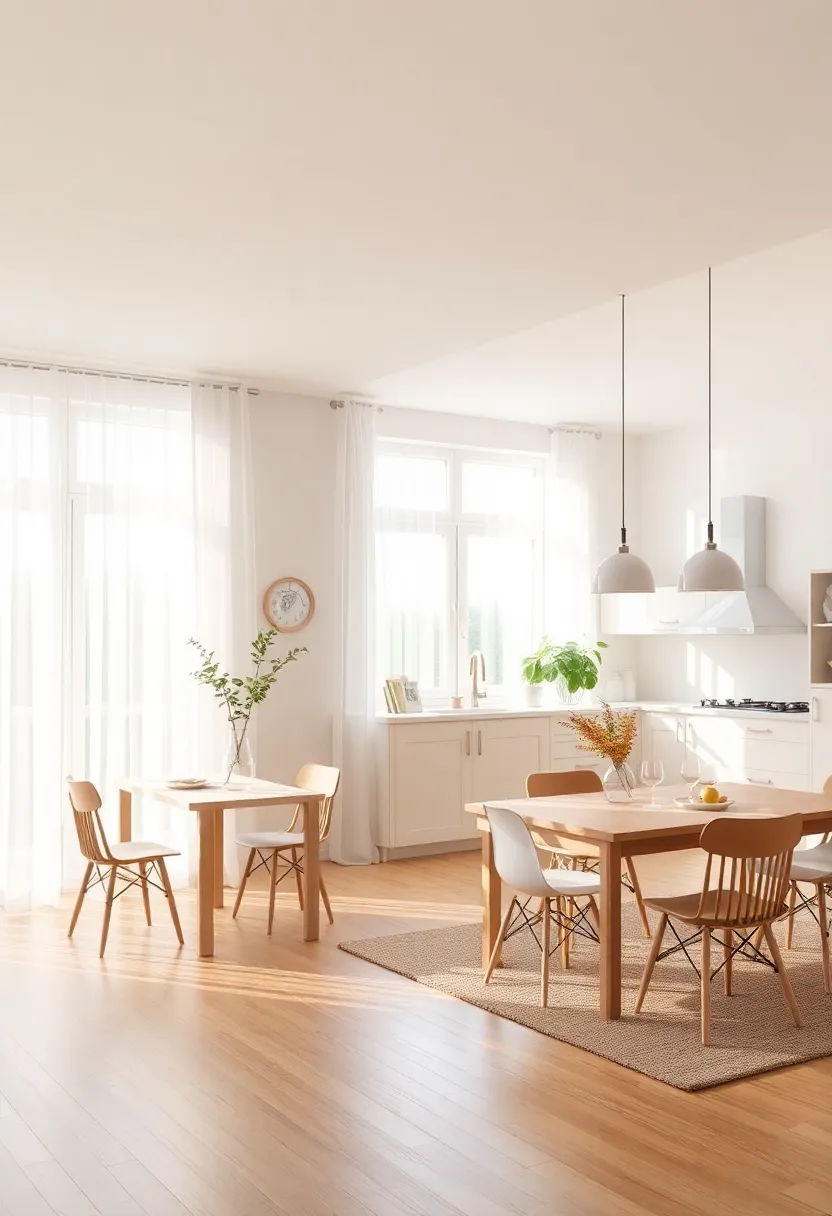
Light, airy curtains can enhance your small open space while providing a soft touch. Choose sheer fabrics that let natural light filter through, maintaining privacy without sacrificing brightness. This approach makes your kitchen-living room feel open and inviting.
For added height illusion, hang curtains higher than the window frame. Light colors that complement your palette create a cohesive look. Using curtain rods that extend beyond the window’s width can make your space feel even larger.
• Hang curtains higher than window frames for height
• Choose light colors for a cohesive appearance
• Use curtain rods that extend beyond window width
• Opt for sheer fabrics for natural light
These simple window treatments can significantly enhance your design, making your space feel bright and welcoming.
Bright and Airy Curtains
Editor’s Choice

OWENIE Sheer Curtains 84 inches Long 2 Panels Set for Living Room/Bedroo…
 Amazon$7.93
Amazon$7.93
Curtain Rods for Windows 32-48 inch, 5/8 inch Matte Black Curtain Rod wi…
 Amazon$7.99
Amazon$7.99
42 Pack Curtain Rings with Clips 1.26″ Interior Diameter,Metal Drapery R…
 Amazon$6.99
Amazon$6.9917. Custom Built-Ins

Custom-built furniture can maximize storage and fit seamlessly into your design. Consider built-in shelves or cabinetry tailored to your space needs. This approach uses every nook and cranny, enhancing functionality without sacrificing style.
When designing, think about creating storage solutions that cater to your lifestyle. Matching materials and colors with your existing decor will enhance the aesthetic. These built-ins can create a streamlined look that makes your small space feel larger.
• Create tailored storage solutions for your needs
• Match materials for a cohesive look
• Enhance aesthetics with custom designs
• Use built-ins for maximized space
These custom solutions will help transform your home into a stylish and functional oasis.
Custom Built-Ins
Editor’s Choice

SONGMICS MAZIE Collection – 43 Inches Folding Storage Ottoman Bench, Ott…
 Amazon$49.98
Amazon$49.98
RICHER HOUSE 5 Set Floating Wall Mounted Shelves, Black Shelves for Wall…
 Amazon$22.99
Amazon$22.99
ClosetMaid Modular Storage 21.38-inch W 3-Shelf Storage Cabinet with Doo…
 Amazon$184.80
Amazon$184.8018. Layered Lighting for Depth

Layering different types of lighting creates depth in your small open space. Combine ambient lighting for overall brightness, task lighting for focused areas, and accent lighting to highlight decor. This blend enhances both functionality and visual interest, making your home inviting.
Mix overhead fixtures with table and floor lamps for varied illumination. Dimmers can help adjust the mood throughout the day. Consider LED strip lights to highlight shelves or under countertops for a modern touch.
• Combine overhead fixtures with lamps
• Use dimmers for mood control
• Add LED strip lights for a modern touch
• Illuminate key areas with accent lighting
Layered lighting encourages a balanced atmosphere, making your space feel warm and welcoming.
Layered Lighting for Depth
Editor’s Choice

Industrial Floor Lamp with Glass Shade – Black, LED Bulbs, Foot Pedal Sw…
 Amazon$29.98
Amazon$29.98
ONEWISH Touch Bedside Lamp for Bedroom, 3-Way Dimmable Farmhouse Table L…
 Amazon$25.49
Amazon$25.49
Led Lights for Bedroom 50ft (1 Roll), Color Changing RGB Led Strip Light…
 Amazon$6.29
Amazon$6.2919. Curated Art Collection
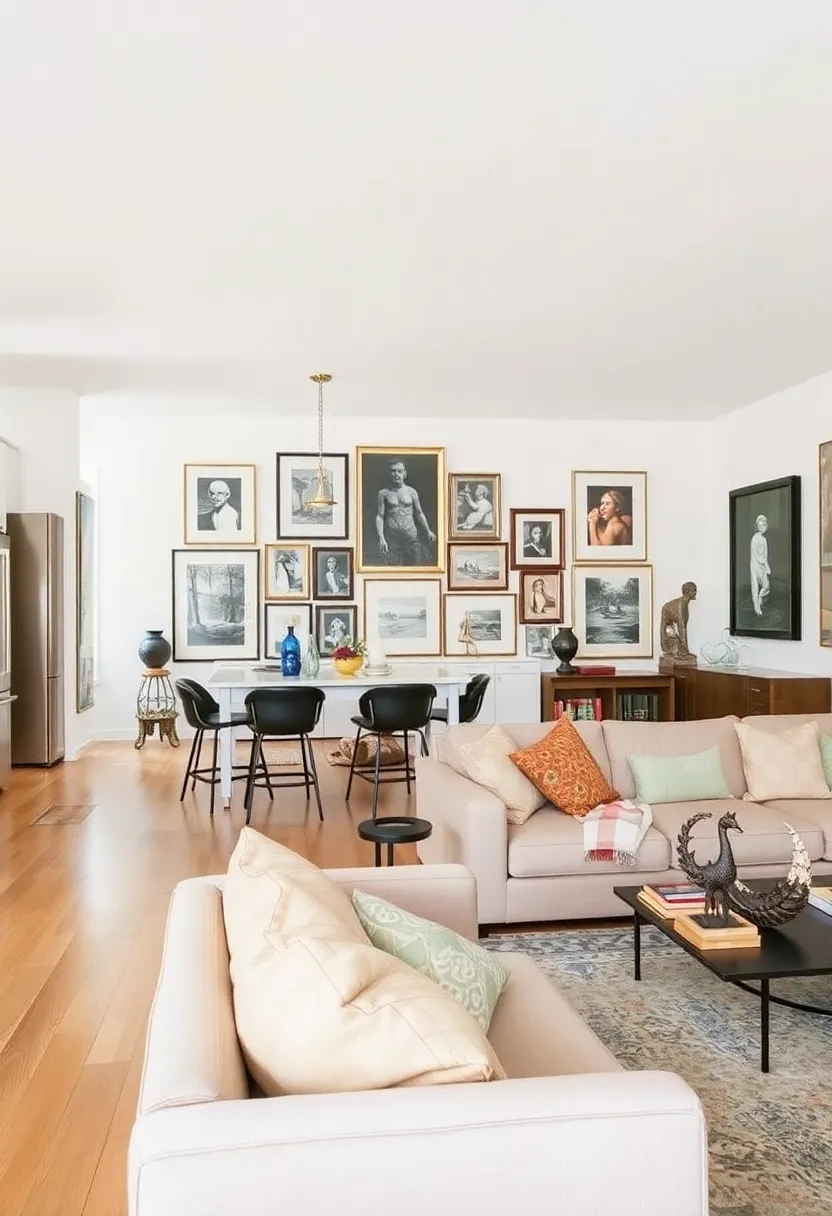
Showcasing a curated art collection adds personality to your open plan kitchen-living room. Mix styles and mediums, such as framed prints and sculptures, to create an eclectic feel. A well-placed piece of art can spark conversations and elevate your decor.
Arrange smaller pieces together for a gallery wall effect or use floating shelves to display three-dimensional art. Incorporating local artists’ work adds a personal touch to your collection. This creative approach makes your space feel uniquely yours.
• Arrange smaller pieces for a gallery wall
• Use floating shelves for 3D art
• Incorporate local artists for personal touches
• Select pieces that resonate with your style
This artistic display allows your personality to shine through, making your small space feel inviting.
Curated Art Collection
Editor’s Choice

Black Man Wall Art African American Men Canvas Wall Decor Black People D…
 Amazon$12.99
Amazon$12.99
RICHER HOUSE 5 Set Floating Wall Mounted Shelves, Black Shelves for Wall…
 Amazon$22.99
Amazon$22.99
Modern Desk Decor ‘Top of The Rock’ – Abstract Sculpture 11″ as Motivati…
 Amazon$59.99
Amazon$59.9920. Repurposed Furniture Ideas
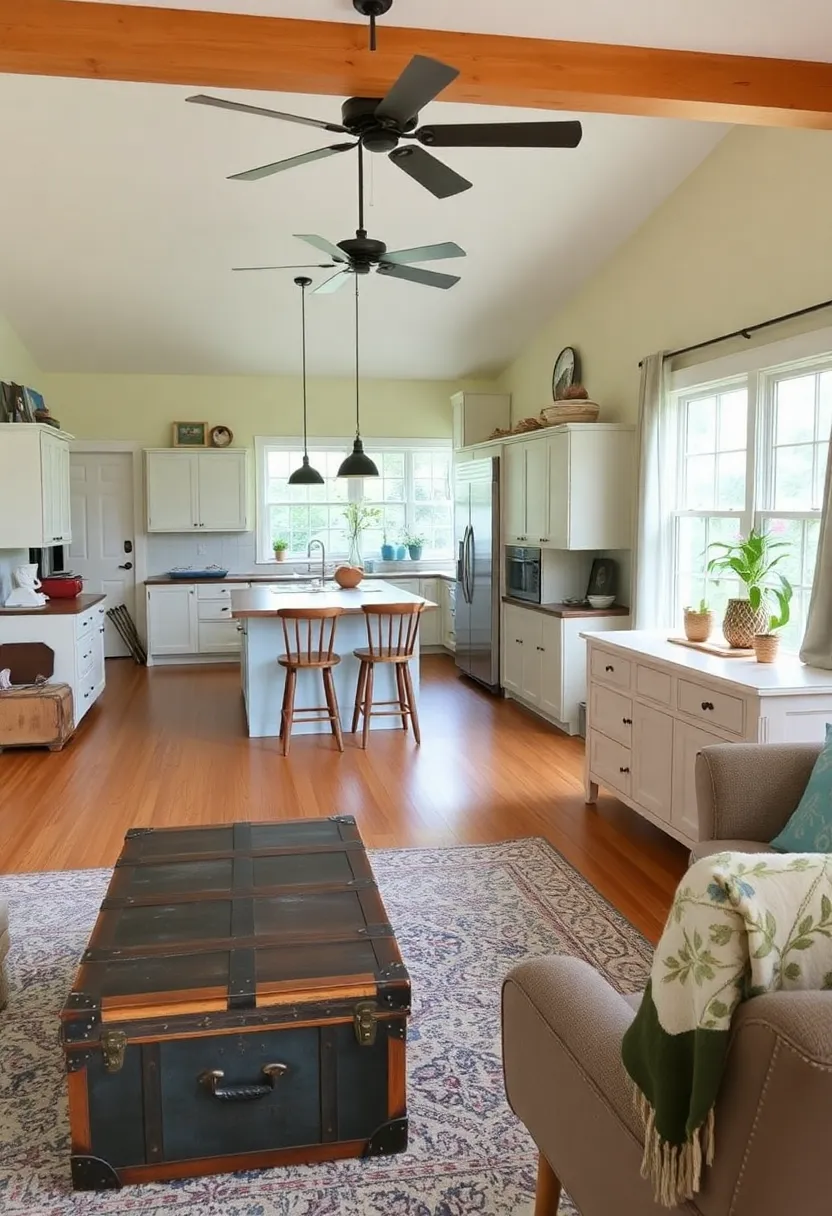
Repurposing furniture adds character to your kitchen-living area while promoting sustainability. Convert an old dresser into a kitchen island or transform a vintage trunk into a coffee table. These creative changes save money and allow you to customize pieces to match your style.
Look for sturdy items that can be easily modified. Don’t hesitate to paint or stain them to fit your decor. New hardware can breathe life into an old piece, giving it a fresh look.
• Convert an old dresser into a kitchen island
• Use a vintage trunk as a coffee table
• Paint or stain furniture to fit your decor
• Add new hardware for a fresh touch
These thoughtful repurposed solutions can give your space a unique identity while being eco-friendly.
Repurposed Furniture Ideas
Editor’s Choice

Black Wood Furniture Paint 7.1oz – Water-based & Low Odor All-in-One No …
 Amazon$9.99
Amazon$9.99
Rustic 12 Gauge Shotgun Shell Drawer Pull/Cabinet Knobs – 4 Pack
 Amazon$19.95
Amazon$19.95
Mens Boys Short 80s 90s Vintage Swim Trunks with Mesh Lining Quick Dry S…
 Amazon$27.99
Amazon$27.9921. Cozy Nooks for Reading
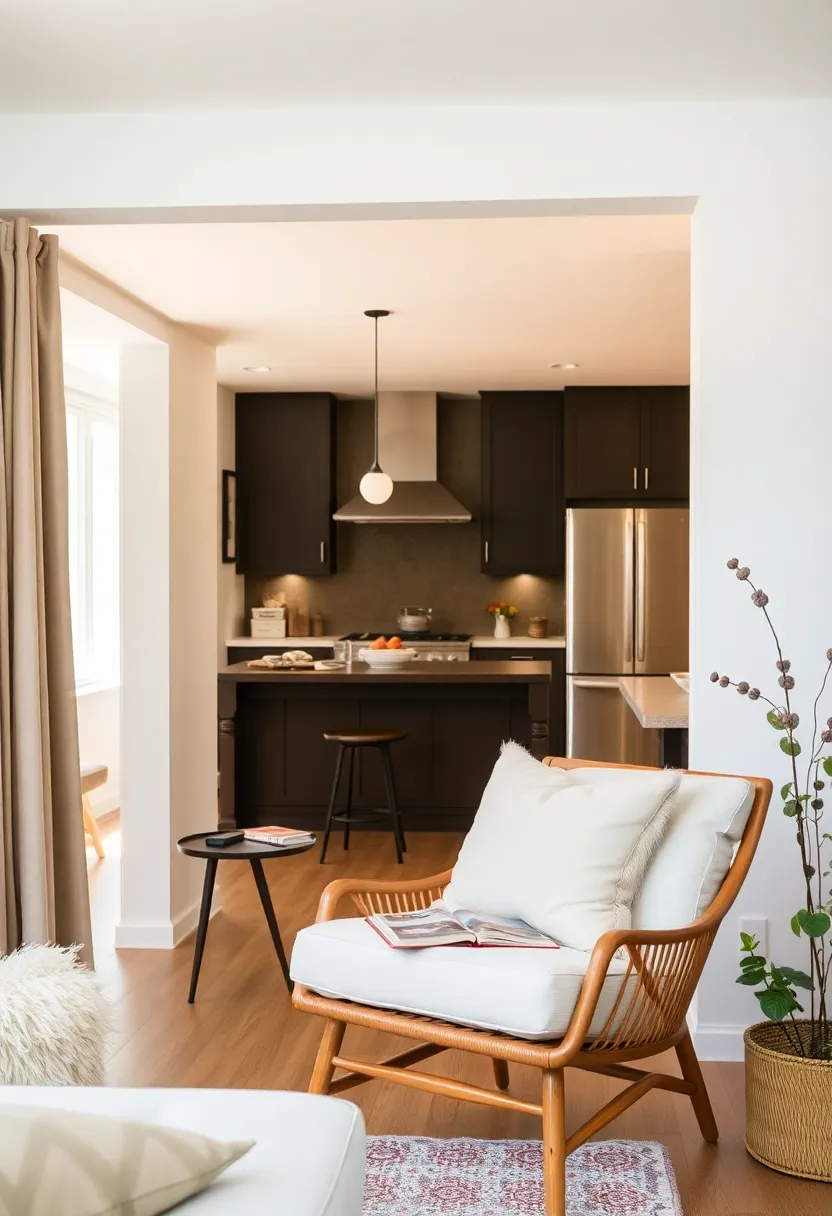
Creating a cozy reading nook in your open plan area adds warmth and relaxation. Find a light-filled corner and add a comfy chair or cushions, along with a small side table for your book and coffee. A small bookshelf can keep your favorite reads within reach.
Consider using an oversized chair for extra comfort, and add a lamp for focused reading light. Decorative throws and pillows enhance the cozy feel. This little retreat can help you unwind, bringing charm to your overall design.
• Use an oversized chair for comfort
• Add a small lamp for reading light
• Include decorative throws for coziness
• Use a floating shelf for book storage
This cozy nook will invite you to relax and enjoy your space even more.
Cozy Nooks for Reading
Editor’s Choice

Oversized Recliner Chair, Big Mans Recliner Chairs for Adults 400LBS, Ex…
 Amazon$309.99
Amazon$309.99
Desk Clip on Lamp for Reading Home Office, 10 Dimmable Brightness 3 Mode…
 Amazon$9.99
Amazon$9.99
Exclusivo Mezcla Fleece Throw Blanket for Couch, Super Soft Striped Jacq…
 Amazon$12.99
Amazon$12.9922. Seasonal Decor Swaps

Changing your decor seasonally keeps your open plan kitchen-living room feeling fresh. Introduce seasonal colors, textiles, and decorations to reflect the time of year. For instance, warm tones and cozy textures in fall can transition to light fabrics and bright colors in spring.
Maintain a collection of versatile decor that can easily switch between seasons. Seasonal plants or flowers add a natural touch. Changing throw pillows and blankets to match the season’s palette keeps things lively.
• Keep a collection of versatile decor for easy swaps
• Use seasonal plants for a natural touch
• Change throw pillows for seasonal palettes
• Incorporate seasonal textiles for warmth
This practice encourages creativity and keeps your home feeling inviting all year round.
Seasonal Decor Swaps
Editor’s Choice

Set of 13 Seasonal Holiday Throw Pillow Covers 18 x 18 in with 12 Interc…
 Amazon$20.99
Amazon$20.99
GROWIT Plant Moisture Meter Houseplants – Accurate Plant Water Meter for…
 Amazon$9.49
Amazon$9.49
Cozy Bliss Luxury Sherpa Throw Blanket for Couch, Premium Reversible Plu…
 Amazon$19.99
Amazon$19.9923. Smart Storage Solutions
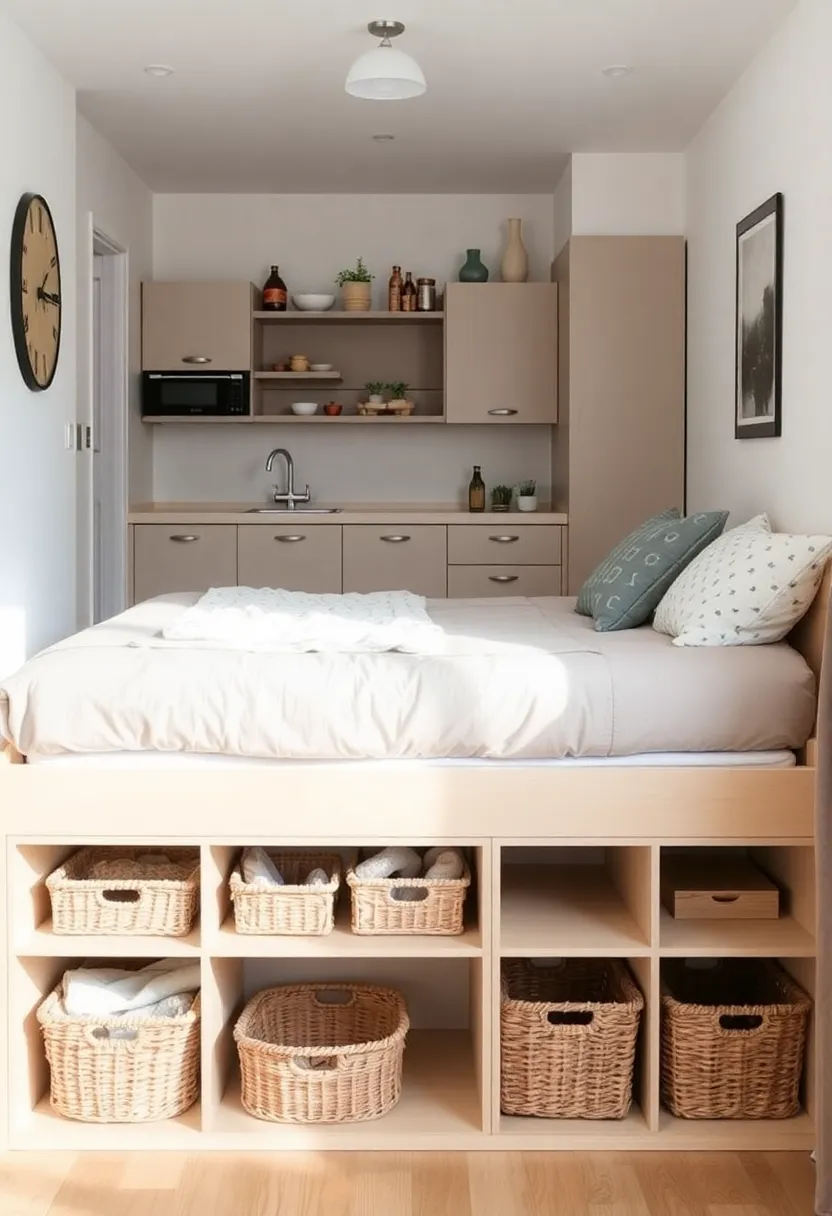
Maximizing storage in a small open kitchen-living area is key to keeping clutter away. Use innovative solutions like under-bed storage or built-in compartments in furniture to make the most of your space. Multi-purpose items, like benches with hidden storage, are both functional and stylish.
Consider using baskets and decorative boxes to keep items organized and out of sight. Labeling containers helps you find things quickly. Vertical storage options, like wall-mounted shelves, can create additional space while keeping things tidy.
• Use decorative boxes for organization
• Consider under-bed storage for hidden space
• Label containers for quick access
• Utilize vertical storage for extra space
These smart storage solutions will help create a clean and organized environment, making your home feel more spacious.
Smart Storage Solutions
Editor’s Choice

Budding Joy 90L Under Bed Storage Containers, Closet Organizers and Stor…
 Amazon$23.99
Amazon$23.99
SLEEPING LAMB Over The Door Shoe Organizer for Closet with Large Deep Po…
 Amazon$19.99
Amazon$19.99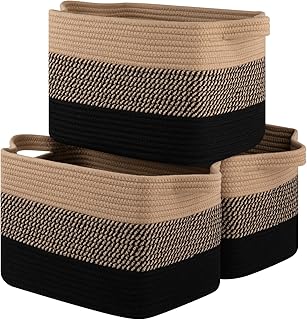
Storage Basket for Organizing, Woven Baskets for Storage, Rectangle Deco…
 Amazon$25.64
Amazon$25.6424. Bar Carts for Stylish Storage

A bar cart can be a stylish addition to your open plan kitchen-living area, providing both storage and charm. Use it to display drinks, glassware, and cocktail essentials while adding visual interest to your decor. Opt for a vintage-inspired cart or a modern design to fit your style perfectly.
Display your favorite spirits and cocktail books, and incorporate decorative items like candles or plants for flair. Keeping your bar cart mobile allows for easy access during gatherings. This creative use of space can become a focal point in your home.
• Use a bar cart for stylish storage
• Include decorative items for added charm
• Display favorite spirits and books
• Keep it mobile for accessibility
This addition will enhance your decor while keeping everything organized.
Bar Carts for Stylish Storage
Editor’s Choice

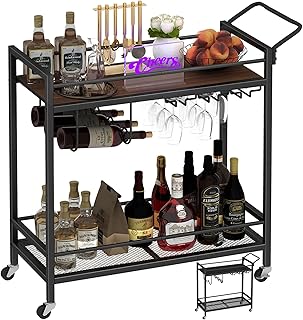
LAATOOREE Bar Cart, Two-Color Home Bar Serving Cart, Mobile Drink Bevera…
 Amazon$49.99
Amazon$49.99
Bartender Kit with Stylish Bamboo Stand, 12 Piece 25oz Cocktail Shaker S…
 Amazon$24.99
Amazon$24.9925. Textured Wall Treatments
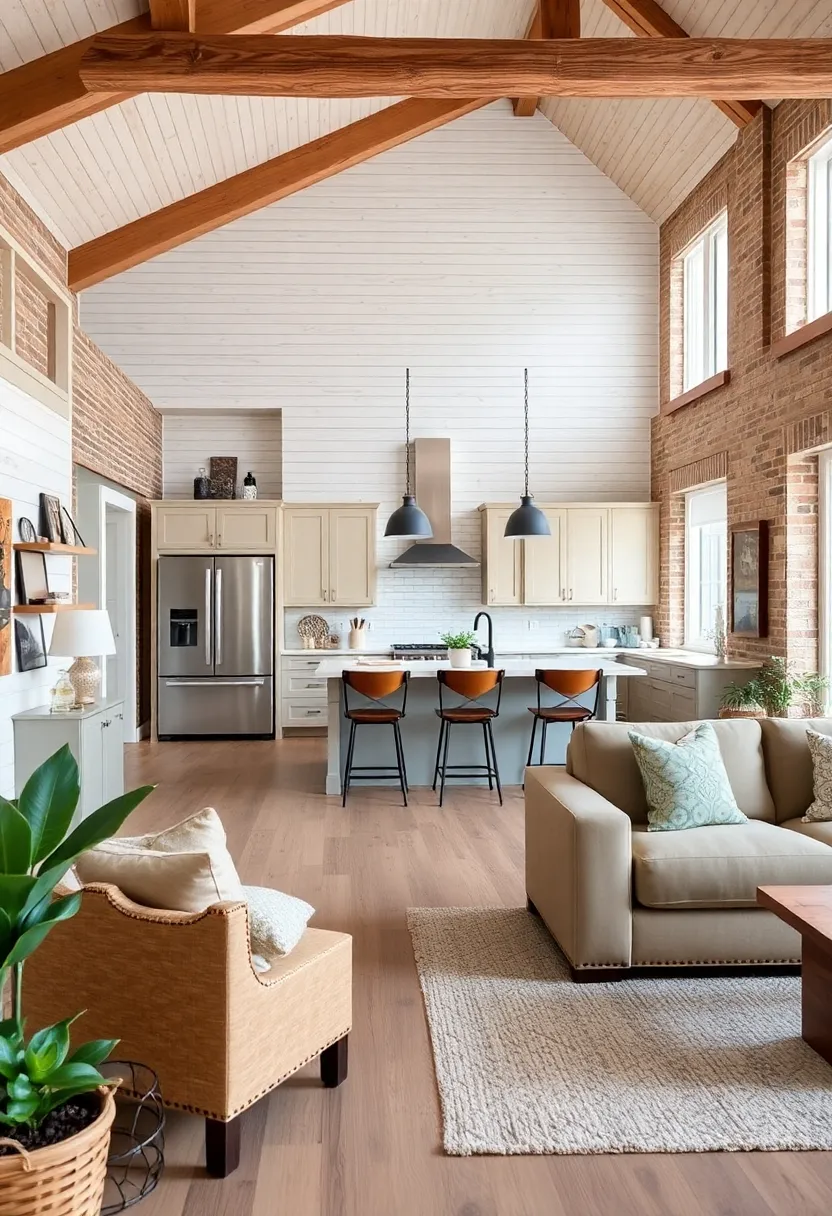
Textured wall treatments can bring depth and character to your open plan kitchen-living space. Think about options like shiplap, exposed brick, or textured wallpaper to create a unique backdrop. These elements enhance your decor while providing a cozy feel.
Consider using wood paneling for rustic charm or stucco finishes for a modern touch. Removable wallpaper is a great choice for easy updates. These textured treatments can make even the smallest spaces feel warm and inviting.
• Use wood paneling for rustic appeal
• Incorporate stucco finishes for a modern look
• Try removable wallpaper for flexibility
• Add textured wallpaper for visual interest
These enhancements will create a welcoming atmosphere in your home.
Textured Wall Treatments
Editor’s Choice

Art3d Slat Wood Wall Paneling for Interior and Ceiling Decoration – Pack…
 Amazon$129.99
Amazon$129.99
15.7″ X 118″ Black Silk Wallpaper Embossed Self Adhesive Peel and Stick …
 Amazon$5.59
Amazon$5.59
26. Recessed Lighting Styles

Recessed lighting is a sleek way to brighten your open plan kitchen-living room without taking up space. This lighting can create a clean and modern look while providing ample illumination. Strategically place recessed lights to highlight key areas, like over the kitchen island or along hallways.
Consider using dimmers to adjust the ambiance as needed. Combine recessed lights with pendant fixtures for a layered lighting effect. Opt for energy-efficient LED options to save on electricity bills while enhancing your space.
• Use dimmers to control light levels
• Combine recessed lights with pendant fixtures
• Illuminate key areas with strategic placement
• Choose energy-efficient LED bulbs to save money
This thoughtful lighting approach will make your small space feel brighter and more welcoming.
Recessed Lighting Styles
Editor’s Choice

Ensenior 12 Pack 6 Inch LED Recessed Ceiling Light, Dimmable, 2700K-5000…
 Amazon$56.69
Amazon$56.69
Leviton SureSlide Dimmer Switch for Dimmable LED, Halogen and Incandesce…
 Amazon$18.50
Amazon$18.50
Modern Black Farmhouse Pendant Light with Glass Shade,Industrial Pendant…
 Amazon$19.99
Amazon$19.9927. Flexible Room Dividers
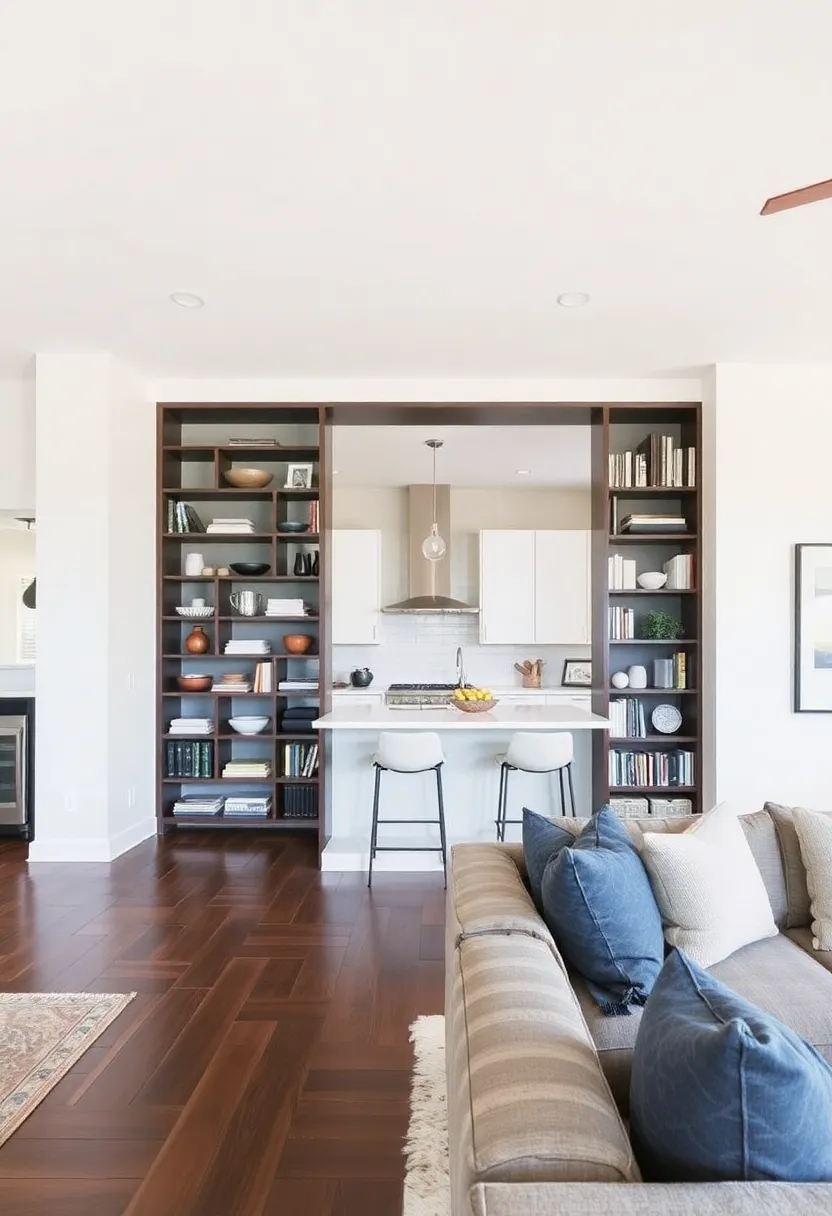
Flexible room dividers can visually separate your cooking and living areas while still maintaining an open feel. Consider using folding screens, sliding panels, or even plants as dividers. This flexibility allows you to change your layout as your needs evolve, making your small space more functional.
Use a bookshelf as a room divider for added storage, or incorporate curtains for a softer touch. Decorative screens can double as art pieces, adding character to your space. This approach keeps your home stylish and organized.
• Use a bookshelf for added storage and division
• Incorporate curtains for a softer look
• Choose decorative screens for visual interest
• Utilize plants as natural dividers
These dividers will create character while defining your space beautifully.
Flexible Room Dividers
Editor’s Choice

Room Divider 6FT Portable Room Dividers and Folding Privacy Screens, 88’…
 Amazon$56.99
Amazon$56.99
MerryNine Clear Book Ends 2pcs, Acrylic Bookends for Shelves, Non-Slip B…
 Amazon$7.99
Amazon$7.99
Artificial Dracaena Tree Indoor, 5Ft Faux Plants Indoor with Black Tall …
 Amazon$69.99
Amazon$69.9928. Colorful Kitchen Appliances

Incorporating colorful kitchen appliances adds fun and personality to your open space. Choose vibrant blenders, toasters, or mixers that pop against neutral backgrounds. These bright accents can serve as both decorative elements and functional tools.
Select retro-style appliances for a nostalgic touch or opt for matching sets to create a cohesive look. Integrating colorful items that tie in with your accent colors enhances your decor. This playful approach infuses your kitchen with character and charm.
• Choose vibrant appliances for a fun touch
• Select matching sets for cohesion
• Use retro-style items for nostalgia
• Tie colors into your decor for added flair
This lively addition can create an enjoyable cooking environment that reflects your personality.
Colorful Kitchen Appliances
Editor’s Choice

Ganiza Blender for Smoothies, 14Pcs Personal Blender for Shake and Smoot…
 Amazon$29.99
Amazon$29.99
Nostalgia Retro Wide 2-Slice Toaster, Vintage Design With Crumb Tray, Co…
 Amazon$39.99
Amazon$39.99
Electric Stand Mixer,10 Speeds Tilt-Head Food Mixer, 3-IN-1 Kitchen Mixe…
 Amazon$79.98
Amazon$79.9829. Wall-Mounted Pot Racks

Wall-mounted pot racks provide a stylish and practical solution to save space in your kitchen-living area. These racks free up cupboard space while allowing you to showcase beautiful cookware. Whether made of metal or wood, they add an interesting design element to your decor.
Hang herb pots to create a mini indoor garden or choose a rack with hooks to store utensils. A rustic style can enhance a farmhouse theme, making your kitchen feel homey and inviting. This clever storage solution keeps your kitchen organized and visually appealing.
• Hang herb pots for a mini garden
• Use a rack with hooks for utensils
• Choose a rustic design for farmhouse charm
• Display beautiful cookware for style
This practical addition will enhance both functionality and aesthetics in your kitchen.
Wall-Mounted Pot Racks
Editor’s Choice
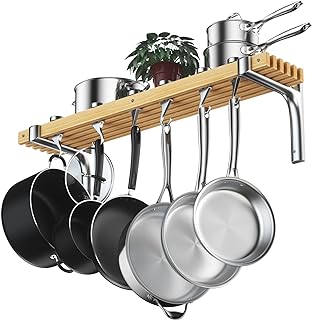
Cooks Standard Wall Mounted Wooden Pot Rack, 36 by 8-Inch
 Amazon$62.99
Amazon$62.99
Herb Planter Indoor – 3 Iron Herb Pots with Drainage Holes, Varnished Ba…
 Amazon$24.99
Amazon$24.99
Kitchen Utensil Holder with 3 Compartments, Rustic Wooden Storage Organi…
 Amazon$23.98
Amazon$23.9830. Cozy Throw Blankets

Adding cozy throw blankets to your open plan kitchen-living room boosts comfort and style. Drape them over the sofa or keep them neatly folded in a basket for easy access. Select soft materials and colors that complement your design for a cohesive look.
Choose textures like knit or faux fur for added warmth, and opt for colors that tie your palette together. Seasonal changes in patterns or colors can refresh your decor throughout the year. This small touch can create a significant difference, making your space feel warm and inviting.
• Use soft materials for warmth
• Choose colors that tie your palette together
• Consider seasonal changes for freshness
• Keep them easily accessible in a basket
This simple addition can greatly enhance the inviting atmosphere of your home.
Cozy Throw Blankets
Editor’s Choice

Bigacogo Chunky Knit Throw Blanket for Couch, 40×60 inches, 100% Hand Kn…
 Amazon$37.98
Amazon$37.98
YUSOKI Black Faux Fur Throw Blanket,2 Layers,50″ x 60″, Soft Fuzzy Fluff…
 Amazon$16.99
Amazon$16.99
Touchat Fleece Throw Blankets, Buffalo Plaid Throw Blanket for Couch Sof…
 Amazon$13.59
Amazon$13.59Conclusion

Transforming a small open plan kitchen-living room into a stylish and functional space is entirely achievable with these 30+ ideas.
Embracing sustainable practices, clever design choices, and personal touches can create a harmonious environment that reflects your unique style.
Consider which ideas resonate with you and take inspiration to curate your perfect urban oasis.
Note: We aim to provide accurate product links, but some may occasionally expire or become unavailable. If this happens, please search directly on Amazon for the product or a suitable alternative.
This post contains Amazon affiliate links, meaning we may earn a small commission if you purchase through our links, at no extra cost to you.
Frequently Asked Questions
What Are the Best Small Open Plan Kitchen Living Room Ideas for Urban Dwellers?
Urban dwellers often face the challenge of maximizing limited space. Consider using functional furniture solutions like a coffee table that doubles as a storage unit or a sofa bed for guests.
Open concept living allows for a seamless flow between spaces. Use color schemes and decor that create a cohesive look, such as matching kitchen and living room elements. Incorporating plants can also add life and freshness to your small space!
How Can I Make My Small Open Plan Kitchen Living Room Feel Larger?
To create an illusion of more space, use light colors and mirrors in your apartment interior inspiration. Choose furniture that is appropriately scaled for your area—oversized pieces can overwhelm a small space.
Consider open shelving in your kitchen to keep things airy and organized. Strategic lighting, such as pendant lights over the kitchen island, can also define areas in your open concept living space without closing it off.
What Are Some Sustainable Decor Ideas for a Small Open Plan Kitchen Living Room?
Sustainable decor is not only eco-friendly but can also be stylish! Look for reclaimed wood for furniture or decor items, which adds character to your kitchen living room decor.
Consider using energy-efficient appliances and LED lighting to reduce your carbon footprint. Incorporating houseplants can purify the air and bring a touch of nature indoors, enhancing both aesthetics and sustainability in your space.
How Do I Choose the Right Color Palette for a Small Open Plan Kitchen Living Room?
Choosing the right color palette can significantly influence the mood and perception of space in your apartment. Lighter shades like whites, creams, and soft pastels can make a small area feel more open.
To add depth, consider accent walls or colorful decor pieces that tie the kitchen and living room together, providing a harmonious flow. Don’t shy away from patterns, but keep them balanced with solid colors to maintain a spacious feel.
What Functional Furniture Solutions Work Best for Small Open Plan Spaces?
In small open plan spaces, multi-functional furniture is your best friend! Look for items like ottomans with storage, extendable dining tables, or nesting tables that can be tucked away when not in use.
Additionally, consider vertical storage solutions, such as wall-mounted shelves, to maximize your space without taking up floor area. These solutions can keep your apartment organized and stylish while enhancing your overall living experience.
Related Topics
home decor
open concept living
small space design
functional furniture
apartment interior
urban living
sustainable design
minimalist style
kitchen living room
space-saving solutions
decor inspiration
beginner friendly
Note: We aim to provide accurate product links, but some may occasionally expire or become unavailable. If this happens, please search directly on Amazon for the product or a suitable alternative.
This post contains Amazon affiliate links, meaning we may earn a small commission if you purchase through our links, at no extra cost to you.
Frequently Asked Questions
What Are the Best Small Open Plan Kitchen Living Room Ideas for Urban Dwellers?
Urban dwellers often face the challenge of maximizing limited space. Consider using functional furniture solutions like a coffee table that doubles as a storage unit or a sofa bed for guests.
Open concept living allows for a seamless flow between spaces. Use color schemes and decor that create a cohesive look, such as matching kitchen and living room elements. Incorporating plants can also add life and freshness to your small space!
How Can I Make My Small Open Plan Kitchen Living Room Feel Larger?
To create an illusion of more space, use light colors and mirrors in your apartment interior inspiration. Choose furniture that is appropriately scaled for your area—oversized pieces can overwhelm a small space.
Consider open shelving in your kitchen to keep things airy and organized. Strategic lighting, such as pendant lights over the kitchen island, can also define areas in your open concept living space without closing it off.
What Are Some Sustainable Decor Ideas for a Small Open Plan Kitchen Living Room?
Sustainable decor is not only eco-friendly but can also be stylish! Look for reclaimed wood for furniture or decor items, which adds character to your kitchen living room decor.
Consider using energy-efficient appliances and LED lighting to reduce your carbon footprint. Incorporating houseplants can purify the air and bring a touch of nature indoors, enhancing both aesthetics and sustainability in your space.
How Do I Choose the Right Color Palette for a Small Open Plan Kitchen Living Room?
Choosing the right color palette can significantly influence the mood and perception of space in your apartment. Lighter shades like whites, creams, and soft pastels can make a small area feel more open.
To add depth, consider accent walls or colorful decor pieces that tie the kitchen and living room together, providing a harmonious flow. Don’t shy away from patterns, but keep them balanced with solid colors to maintain a spacious feel.
What Functional Furniture Solutions Work Best for Small Open Plan Spaces?
In small open plan spaces, multi-functional furniture is your best friend! Look for items like ottomans with storage, extendable dining tables, or nesting tables that can be tucked away when not in use.
Additionally, consider vertical storage solutions, such as wall-mounted shelves, to maximize your space without taking up floor area. These solutions can keep your apartment organized and stylish while enhancing your overall living experience.
Related Topics
home decor
open concept living
small space design
functional furniture
apartment interior
urban living
sustainable design
minimalist style
kitchen living room
space-saving solutions
decor inspiration
beginner friendly

